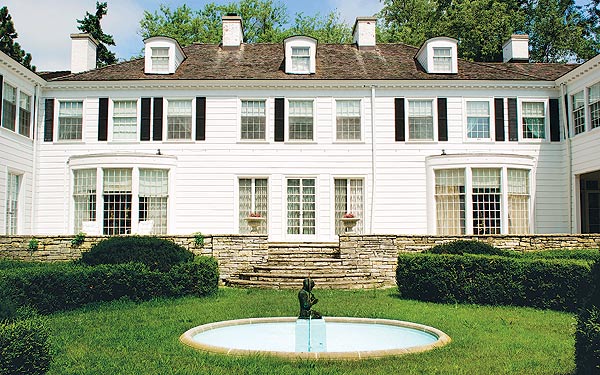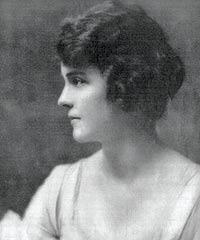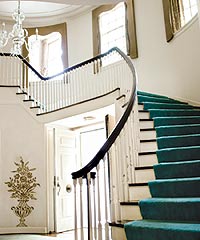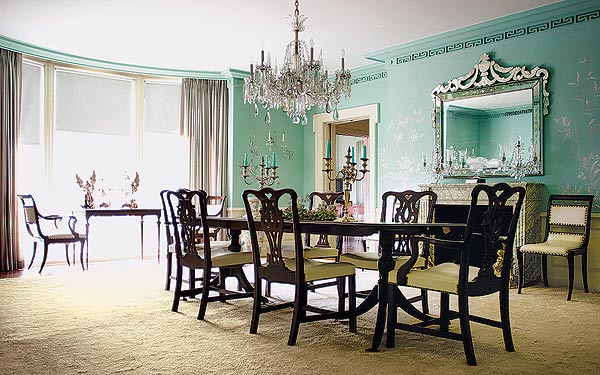
One of Chicago’s significant literary landmarks, the Lake Forest home of the self-possessed society belle who was F. Scott Fitzgerald’s first love and the model for the radiantly self-centered Daisy Buchanan in his novel The Great Gatsby, is for sale for the first time in more than 50 years.
The house dates back to 1905, when the architect Howard Van Doren Shaw, who designed many North Shore manors, built the place as a summer getaway for Charles B. King, a prosperous Chicago banker. Shaw gave the house broad overhangs to shade the four family bedrooms and a curvaceous main staircase that winds around the perimeter of a grand foyer. Eventually the place passed on to King’s son, Charles G. King, a wealthy stockbroker, who called the house and its 50 acres Kingdom Come Farm.

Ginevra King |
In 1915, King’s daughter Ginevra was a 16-year-old beauty, one of Chicago’s “Big Four” debutantes, visiting St. Paul, Minnesota. There she met and became, in her words, “dipped about” Scott Fitzgerald, then a student at Princeton. Their romance, conducted primarily through their letters to each other, lasted about two years, according to The Perfect Hour, a book about their relationship by James L. W. West III, a professor of English at Penn State.
Although the pair got together mainly on the East Coast, where they were both in school, Fitzgerald visited Lake Forest twice, in June 1915 and in August 1916. West couldn’t say definitively that Fitzgerald set foot on Kingdom Come Farm, only that he “stayed with a wealthy relative who lived in Lake Forest, but it seems reasonable he would have visited Ginevra in her house.”
Regardless of whether he saw the house, Fitzgerald went on to immortalize Ginevra—who abruptly broke up with the middle-class Minnesotan to marry a rich Chicago boy—in The Great Gatsby. She is widely acknowledged as a significant inspiration for Daisy Buchanan, the fragile goddess from Louisville who tossed over the striving Jay Gatsby to marry the rich Chicagoan Tom Buchanan.
Toward the end of his life, Fitzgerald—who died of a heart attack in 1940, only 44 years old—continued to refer to Ginevra as “the love of my youth.” Ginevra died in 1980, when she was 82. (Coincidentally, the mansion where Ginevra lived with Bill Mitchell, her first husband, is also for sale; the 14-room house, where Ginevra lived from 1918 until her divorce in 1939, sits on five acres in east Lake Forest and is listed at $6.5 million with Koenig & Strey GMAC.)
Photograph: Arnold Genthe/Office of Communications, Princeton University
 |
In 1954, the Chicago businessman Frank Reilly and his wife, Antoinette, bought the Kingdom Come Farm property from its third owners, at about the same time that littérateurs anointed Gatsby, initially only a modest success, a Great American Novel. The Reillys knew of the connection to Fitzgerald, but “they didn’t spend a lot of time thinking about it,” says their son, Dennis, a 68-year-old retired physicist now living in Boston. With both parents now dead, he and his two siblings have decided to sell the house and the surrounding eight and a half acres. The house is listed with Houda Chedid of Baird & Warner, with an asking price of $6 million.
The house, which Shaw made wide and shallow to catch cross breezes, has remained largely unchanged since 1954. There is molding in a Grecian key pattern carved in the plaster of the living-room walls, murals on the dining-room walls, four light sconces in the dining room that past owners told the Reillys were Baccarat crystal, brightly colored panels of vitreous tile on the walls of five bathrooms, and a green onyx mantel over the fireplace in the master bedroom. The small kitchen needs an upgrade, but because it sits amid a cluster of butler’s and cook’s rooms, an expansive modernization would not compromise the integrity of the living spaces.
“It’s a rare, rare property,” says Chedid, who notes that a servant’s house and a stable (with another two acres) are also for sale separately, at a price to be negotiated. Dennis Reilly says his family kept as many as eight polo ponies in the stable when he was young.

“[My parents] didn’t like to advertise the [Fitzgerald] connection,” says Reilly, “but it didn’t always come up, either. In fact, more people asked about the [dining room] chandelier” (pictured above).
But with the enduring fame of The Great Gatsby, that connection maintains a powerful allure. “I read the book differently now that I’ve been in the house,” Chedid says. Standing in the foyer, a visitor can imagine the class-conscious Fitzgerald waiting for his upper-crust love to descend from the rooms above. And looking across the broad stone terrace and formal gardens out back, he can easily envision one of Gatsby’s outrageous parties—although there is no green light beckoning from the Buchanans’ dock across the bay.
Photograph: Chris Guillen


